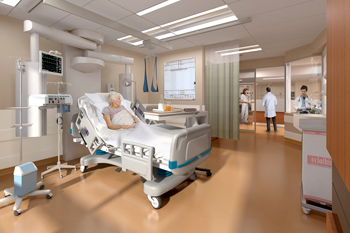Hearts in the right place

By Kate Manicom

An architect’s rendering of a patient room in the CICU. (Rendering by NORR Architects)
St. Michael’s Cardiac Intensive Care Unit treats some of the most critically ill patients in the region – typically those recovering from acute coronary syndromes such as heart attacks. As part of the 3.0 redevelopment project, the unit is making a much-needed move from its current location in the hospital’s Bond Wing to new space in the Peter Gilgan Patient Care Tower, now under construction.
“The CICU team provides excellent care in a small space, but day-to-day we face multiple challenges,” said Dr. Neil Fam, an interventional cardiologist and director of the CICU. “The rooms are so small that we can’t fit all of the necessary equipment in at once and still have room for patients’ families. It’s always very crowded.”
The new, twice-as-large, modern CICU has been designed with more than just space in mind. The layout is patient-centred, with dedicated family space in each room. There will be lockers for family members to safely store their belongings and each room will have a roll-out cot so they can sleep close by.
“When a patient has a crisis, it’s a crisis for the family, too,” said Stephen Penticost, a registered nurse in the CICU. “It’s important that there is space for families to be part of a patient’s care.”
The rooms are all single-patient, each with its own washroom. These elements not only improve patient and family comfort, but are best practices in infection prevention and control. Access to natural light will be available in each room, which is shown to help improve healing.
The layout of the rooms and optimization of new technology will give staff and physicians the ability to better observe patients without disturbing them unnecessarily. Ceiling-mounted articulating arms for lights and monitors means that staff can move equipment out of the way to improve access to patients and make efficient use of the space.
Did you know? The new, 10-bed CICU will be more than twice as large as the current unit, growing from 7,000 square-feet to over 14,000. |
Dr. Fam said the location of the unit also will improve care.
“There is a direct path to the catheterization lab – where patients are typically taken after a heart attack and before they are brought to the CICU. The cardiology unit, where patients recover after transfer from the CICU, is also adjacent,” said Dr. Fam.
Planning for the new CICU took several years and involved a multi-disciplinary team, including physicians, the clinical leader manager, nurses, physiotherapists, respiratory therapists and clerical staff working with the Planning Department and the hospital’s architects.
Penticost, who has been a part of the planning for the new CICU since it began, said he was happy to have had the opportunity to help shape the designs.
“The most exciting change is going to be the space: more space for frontline staff to do their jobs, to consult with other team members and for families,” said Penticost. “We’re looking forward to the move.”
About St. Michael’s Hospital
St. Michael’s Hospital provides compassionate care to all who enter its doors. The hospital also provides outstanding medical education to future health care professionals in 27 academic disciplines. Critical care and trauma, heart disease, neurosurgery, diabetes, cancer care, care of the homeless and global health are among the hospital’s recognized areas of expertise. Through the Keenan Research Centre and the Li Ka Shing International Healthcare Education Centre, which make up the Li Ka Shing Knowledge Institute, research and education at St. Michael’s Hospital are recognized and make an impact around the world. Founded in 1892, the hospital is fully affiliated with the University of Toronto.
